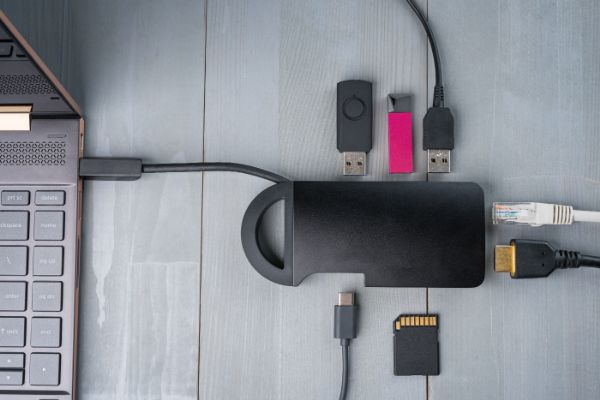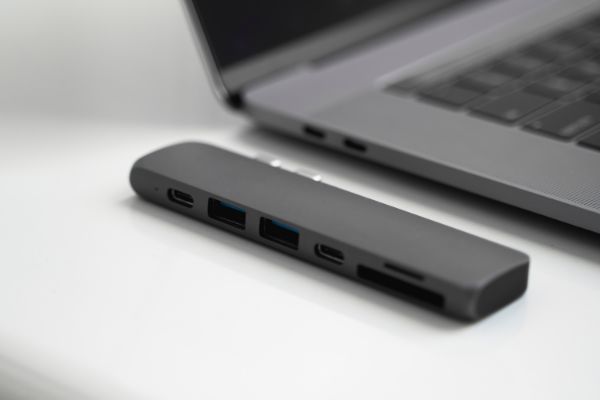Disclaimer: This post may contain affiliate links, meaning we get a small commission if you make a purchase through our links, at no cost to you. For more information, please visit our Disclaimer Page.
A USB hub comes in handy when you have tools and gadgets you want to use simultaneously. It allows you to add more ports to your laptop or another device. Although new computers already have several ports, you might need an extra more. Check out the difference between a powered and an unpowered USB hub to find out which one is right for your system.
Table of Contents
Powered vs. Unpowered USB Hubs
The most significant difference between these USB hubs is that one draws power from your computer, and the other does not. A powered USB hub uses your home’s electrical system to charge.
An unpowered USB hub uses your computer’s power. Some also refer to these as non-powered USB hubs.
A few years back, laptops and other computers had multiple USB ports. Some placed this along the side in spots that were easy to reach. Others put one or more on the back.
The downside of having the ports on the back is you might accidentally unplug devices. It is also difficult to organize the cords in this kind of system.
Now, laptops have only two ports. Some models even have one USB slot or none at all. Using a powered or unpowered hub gives you more slots to use.
Powered Hubs
Powered and active USB hubs are the same. This hub needs some power to run your USB devices. It gives you ten more extra ports to use. Just plug the attached cord into your wall outlet to use it.
Some models come with a removable cable. One of the nice things about a powered USB hub is that it divides the bandwidth equally among any devices you connect to the hub.
Unpowered Hubs
Unpowered hubs are also called passive or non-powered hubs. That’s because they have no external power source. Instead, they depend on your computer’s power.
Because of this, they are not compatible with high-voltage devices. Doing so can drain your computer’s battery faster than regular use.
How are They Similar?
Knowing the differences between powered and unpowered USB hubs can help you decide which one to buy. But don’t disregard their similarities.
Both expand the number of USB ports you have and work with different devices. They also help regulate the bandwidth speed of the devices you use with the ports.
But powered hubs are more efficient in dividing maximum bandwidth among devices.
Both of them also have a power capacity of 500mA. A powered hub gives the maximum power capacity per hub. But an unpowered hub only gives you this amount per port or slot.
When to Use a Powered or Unpowered Hub
While both are handy, unpowered and powered hubs have different uses and applications. It depends on how much power your electronics and devices draw and their technology.
Using a Powered Hub
A powered USB hub is best used for multiple devices or gadgets that all need a lot of power. Some examples include scanners and printers. Though some have wireless connections, others require a wired connection.
These devices take so much power from your computer that you have difficulty doing other tasks when you try to run them simultaneously. External hard drives also draw a lot of energy. Thus, they work well with a powered USB hub.
Choose a powered USB hub when you worry about your devices not performing to your expectation. When plugged into an outlet, a powered hub allows you to use the maximum voltage in each port. So even if you use every available port,you don’t need to worry about your scanner running slowly or your external hard drive acting sluggish. All your devices can run at maximum power if you keep them plugged into the hub.
Using an Unpowered Hub
Unpowered USB hubs work best with devices that do not need a lot of power to run.For example, you can plug in a keyboard or a wireless mouse without using your touchpad.
Cell phones do not need a lot of power either. You can charge them in one of your available ports to charge your phone while browsing Facebook or using your favorite app. Flash drives and game controllers also work well with non-powered hubs.
Remember that using multiple USB devices will draw more power from your computer. When you try to use too many, your system slows down. Your computer might even crash. If you buy the wrong unpowered hub, you risk not having enough power for all of your devices. Unpowered hubs can work with both USB cords and USB adapters.
Pros and Cons of USB Hubs
Looking at the pros and cons of each USB hub gives you an idea of which is the best for your system and devices. They are suitable for home and work use and have some excellent benefits. Make sure you consider the pros and cons of powered and unpowered USB hubs.
Powered USB Hubs – Pros & Cons
It would help if you started to look at powered USB hubs. While they are more expensive, they are easy to use and pull power from any wall outlet. So, as long as you have a free outlet in the room, you can plug it in and start using it.
They work well with devices that need a lot of power to run. The biggest downside is they cost more. They also need a dedicated outlet and cost. Though you can use one to power RGB products, it does not have enough power to run a laptop or tablet.
Unpowered USB Hubs – Pros & Cons
Use an unpowered hub if you have one or more accessories you want to use with your computer. They work well with accessories you use for work or fun, such as a mouse or keyboard. They also provide enough power for speakers and USB desk fans.
Unpowered hubs are space-savers because of their compact size. You can carry one in your bag to work. These hubs only need one available port and are cheap. However, remember that they can consume a lot of power away from your computer. As a result, you might have difficulty running multiple devices. Lastly, an unpowered hub may have a less-than-stellar power flow.
Reasons to Use a USB Hub
Many of the electronic devices you use today work with a USB cord. With a powered hub, you don’t even need USB ports on your computer. A USB hub also allows you to charge some devices faster.
Don’t forget that you can choose a hub that has more than just USB ports to transfer data between devices or listen to music with headphones.
What to Look for in a USB Hub
There are several things to consider to make sure you buy the right USB hub. First is the number of slots it has. While some prefer a hub with three ports, others want one with ten or more ports. Getting a larger one gives you more space for your peripherals.
It would help if you also looked at the connection to the host type it offers. Type A connectors are quite popular because many cell phones and other mobile devices use these connectors. For new phones, like Samsung or another top brand, use a USB-C connector. While Type A connectors only fit in one specific way, USB-C connectors will fit the slot no matter how you insert it.
It’s helpful to pick a hub that has other connections, too. An ideal hub can become a docking station that caters to your needs. You might also check one with an ethernet port that works with a cable. Then, you can run it from your computer, modem, or an audio jack to use the hub with your headphones.
Some have VGA and HDMI ports. If you have multiple devices that use different connections, look for one with a number of ports. You’ll also find some that include a slot for an SD card.
Make sure that you also pick a hub that uses a modern form of USB technology. You might come across a 1.0 USB hub that isn’t compatible with today’s devices. A 3.0 USB hub is better because it is compatible with most devices. Your best bet is a 4.0 USB hub because it works with all the devices you own and should work with any you buy later.
Conclusion
USB hubs are great for home or work because they give you more space. However, they have their similarities and differences as well as their pros and cons. Look at the points presented in this article to help you choose the best hub for your needs.


